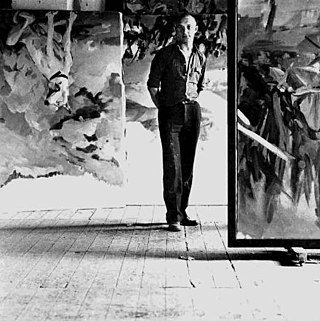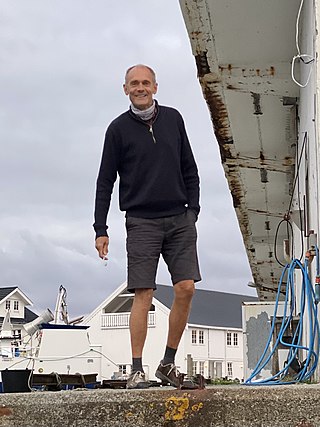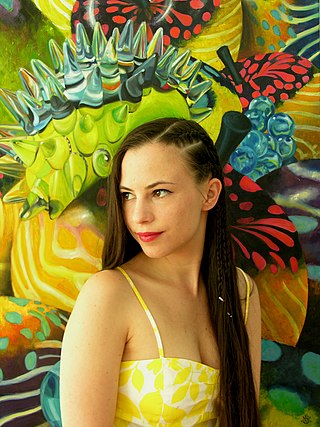
Georg Baselitz is a German painter, sculptor and graphic artist. In the 1960s he became well known for his figurative, expressive paintings. In 1969 he began painting his subjects upside down in an effort to overcome the representational, content-driven character of his earlier work and stress the artifice of painting. Drawing from myriad influences, including art of Soviet era illustration art, the Mannerist period and African sculptures, he developed his own, distinct artistic language.

The Kunsthaus Tacheles was an art center in Berlin, Germany, a large building and sculpture park on Oranienburger Straße, in the sub-neighborhood of Spandauer Vorstadt in the Mitte district. Huge, colorful graffiti-style murals were painted on the exterior walls, and modern art sculptures were featured inside. The building housed an artist collective from 1990 until 2012.

Hans K. Schuler was a German-born American sculptor and monument maker. He was the first American sculptor ever to win the Salon Gold Medal. His works are in several important museum collections, and he also created many public monuments, mostly for locations in Baltimore, Maryland and in the Washington, D.C. area. For over a quarter of a century he served as president of the Maryland Institute College of Art.

A museum is distinguished by a collection of often unique objects that forms the core of its activities for exhibitions, education, research, etc. This differentiates it from an archive or library, where the contents may be more paper-based, replaceable and less exhibition oriented, or a private collection of art formed by an individual, family or institution that may grant no public access. A museum normally has a collecting policy for new acquisitions, so only objects in certain categories and of a certain quality are accepted into the collection. The process by which an object is formally included in the collection is called accessioning and each object is given a unique accession number.

Paul Durand-Ruel was a French art dealer associated with the Impressionists and the Barbizon School. Being the first to support artists such as Claude Monet, Camille Pissarro, and Pierre-Auguste Renoir, he is known for his innovations in modernizing art markets, and is generally considered to be the most important art dealer of the 19th century. An ambitious entrepreneur, Durand-Ruel cultivated international interest in French artists by establishing art galleries and exhibitions in London, New York, Berlin, Brussels, among other places. Additionally, he played a role in the decentralization of art markets in France, which prior to the mid-19th century was monopolized by the Salon system.

The Berlin Secession was an art movement established in Germany on May 2, 1898. Formed in reaction to the Association of Berlin Artists, and the restrictions on contemporary art imposed by Kaiser Wilhelm II, 65 artists "seceded," demonstrating against the standards of academic or government-endorsed art. The movement is classified as a form of German Modernism, and came on the heels of several other secessions in Germany, including Jugendstil and the Munich Secession.
CRG Gallery was an art gallery on New York City's Lower East Side, located at 195 Chrystie St. CRG was founded in 1990 by Carla Chammas, Richard Desroche, and Glenn McMillan.
Noam Braslavsky is an Israeli artist and curator who lives and works in Berlin.
Hosfelt Gallery in San Francisco, California was founded in 1996 by Todd Hosfelt to exhibit contemporary international artists working in all media.

Pola Brändle is a German collage/decollage artist who lives and works in Berlin Kreuzberg, Germany.

Erik Niedling is a German artist. He is also known for his 2010 film The Future of Art, a documentary on the contemporary art scene.

Léonce Rosenberg was an art collector, writer, publisher, and one of the most influential French art dealers of the 20th century. His greatest impact was as a supporter and promoter of the cubists, especially during World War I and in the years immediately after.

Post-Internet is a 21st-century art movement involving works that are derived from the Internet or its effects on aesthetics, culture and society.

Enfants Terribles also Nana ET Matvey is an artist duo consisting of Nana Rosenørn Holland Bastrup and Matvey Slavin. The duo was founded in Hamburg in 2012 and named after their installation Enfants Terribles which, in May 2012, was exhibited on the large paved area outside the Hamburger Kunsthalle in Hamburg. The installation Enfants Terribles was a homage to the spider sculpture Maman by Louise Bourgeois, and consisted of sixteen baby spiders around Bourgeois' existing sculpture.

Johannes Holt Iversen is a Danish painter and sculptor living and working in Amsterdam, Netherlands since 2016. He is an apprentice of Danish painter and sculptor Erik Rytter.
Johann König is a German art dealer, and the founder of König Galerie. Since 2019 he has faced multiple allegations of sexual misconduct. König's attorney obtained an injunction from the Hamburg Regional Court because of false factual allegations and inadmissible reporting of suspicions. With the judgment of the court, essential parts of the reporting are prohibited.

Martin Nannestad Jørgensen is a visual artist living and working in Copenhagen, Denmark. His main medium is textile.

Naomi Devil, originally Noémi Anna Ördög, is a Hungarian painter and graphic designer.
Elżbieta Jabłońska is a Polish contemporary visual artist, and professor. She has served as the Chair of Drawing and has taught art at Nicolaus Copernicus University in Toruń since 1996. Jablonska is known for photography, film, installation art, and performance art. Her artwork engages with Polish stereotypes and myths of women, mothers, and the Catholicism. She lives in Bydgoszcz in northern Poland, in a farming cooperative.















